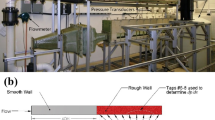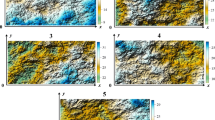Abstract
Surface roughness measurements carried out on polished samples of cementstone seem to indicate that cement paste, after having been subjected to vibration, might be able to preserve the pattern of a standing wave. Measurements were made with a computerized surface roughness instrument. This instrument uses the same principle of mechanical sensing with a fine needle as that found in gramophones. Although the polishing procedure does influence the microtopography of the sample, it is believed that ultra-fine polishing creates a surface that reflects to a large degree the capillary porosity of cementstone. In a series consisting of 7 cementstone samples with different water/cement ratios, variations in Predominant Depth Densities were found suggestive of the recording of a standing wave pattern by the cementstone.
Résumé
Des mesures de l’inégalité de surface effectuées sur des échantillons de ciment durci semblent indiquer que la pâte de ciment vibrée peut conserver une configuration d’ondes stationnaires. Les mesures ont été réalisées avec un palpeur relié à un ordinateur. Cet instrument repose sur le principe du pick up: des déplacements verticaux sont palpés par une aiguille fine. Bien que la procédure de polissage influence le microrelief du ciment, l’auteur suppose que le polissage ultra-fin produit une surface représentative à un haut degré de la porosité capillaire du ciment durci. On a observé des variations significatives de la Densité de Fond Dominante indiquant un mécanisme de conservation des ondes stationnaires par le ciment durci.
Similar content being viewed by others
References
Hillmann W.—Forschung und Entwicklung auf dem, Gebiet der Rauheitsmessung. Technisches Messen, Vol. 47, 1980, pp. 169–174, pp. 209–218, pp. 273–283.
Deelman J. C.—Automatic grain size analysis by means of electro-mechanical surface measurements. Jour. Sed. Petrol., Vol. 42, 1972, pp. 732–735.
Deelman J. C., Deelman G. J.—Textural analysis of sediments by means of surface roughness measurements. Neues Jahrbuch für Geologie, Pal., Monatshefte, 1975. pp. 65–81.
Deelman J. C.—Textural analysis of concrete by means of surface roughness measurements. Matériaux et Constructions/Materials and Structures, Vol. 17, 1984, pp. 359–367.
Schmaltz G.—Technische Oberflächenkunde. Springer Verlag, Berlin, 1936, 286 p.
Posey, C. J.—Measurement of surface roughness. Mechanical Engineering, Vol. 68, 1946, pp. 305–306, p. 338.
Pesante M.—Determination of surface roughness topography by means of amplitude density curves. CIRP-Annalen, Vol. 7, 1963, pp. 61–68.
Silin R. I., Frederick J. R.—Instrumentation for the analysis of the profile of machined surfaces. Anals CIRP, Vol. 15, 1967, pp. 295–300.
Sasse H. R., Fiebrich M.—Bonding of polymer materials to concrete. Matériaux et Constructions/Materials and Structures, Vol. 16, 1983, pp. 293–301.
Woods H.—Durability of concrete construction. Am. Concrete Institute. Detroit, 1968, 187 p.
Powers T. C.—Vibrated concrete. Proc. Am. Concrete Institute, Vol. 15, 1933, pp. 373–381.
Author information
Authors and Affiliations
Rights and permissions
About this article
Cite this article
Deelman, J.C. Standing waves in cementstone?. Materials and Structures 19, 395–400 (1986). https://doi.org/10.1007/BF02472130
Issue Date:
DOI: https://doi.org/10.1007/BF02472130




